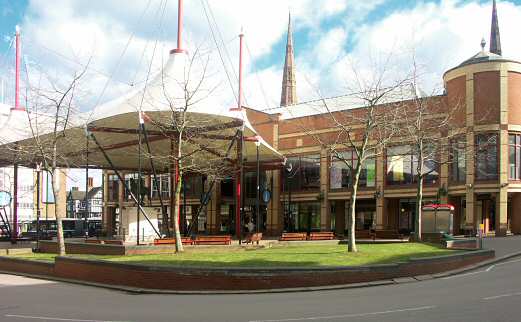
CovSoc founder member, Paul Maddocks, reflects on the way that plans change – not always for the better! Paul writes……
Coventry city centre has seen many changes over the past decades and centuries and the Broadgate area has seen more than most. It was a wide road running from north to south, then it was a very large traffic island and now it has become a traffic free pedestrian area.
It is said that on this site was the very early Norman defensive castle, known as a motte and bailey. That was demolished in the late 12th century and St Mary’s Guildhall was built on part of the site, Caesar’s tower being the only part left of one of the castle towers. St. Michael’s chapel was in the centre of the bailey. This chapel grow over time to become St. Michael’s Church, one of the largest parish churches in the country, which then became a cathedral. There is no sign of the castle any more. Over time it has been built on, including a gaol and then the county court, a public library and various shops and trades. This area was badly hit by bombs in the Coventry Blitz (see map – red areas are where the bombs struck).
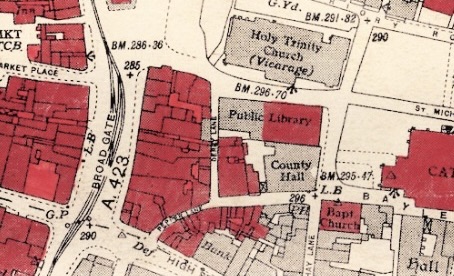
After the war the area became a temporary row of prefabricated shops. These were still standing in the late 1960’s. I can remember in 1966 being turned away from Lyons’ tea rooms for having too long hair. I was 16 at the time (see photo of what I looked like then), I am not sure if you would call it long now. The ban was due to the fact the tea rooms had been pestered with long haired motorcycle riders who would sit in the window and put off customers.
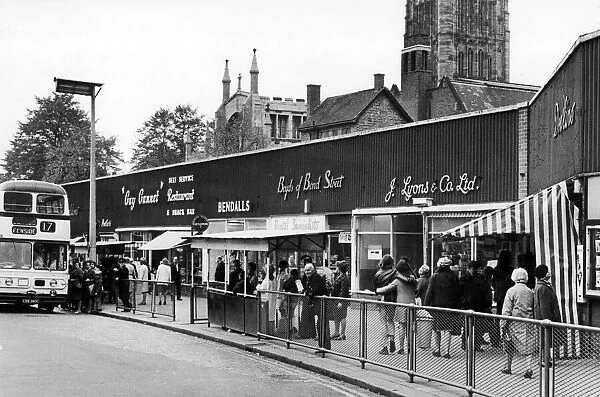
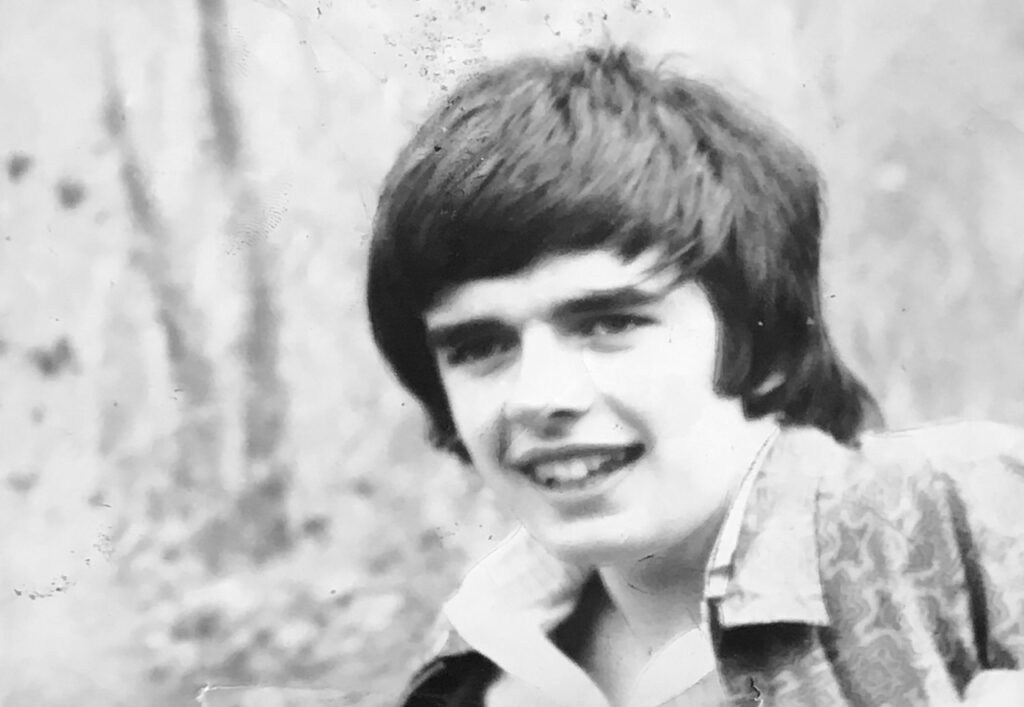
In the mid 1970’s the area was demolished and an archaeological dig was made over the site. This yielded some amazing finds of pottery and a large collection of medieval shoes. It was thought this could have been a site of a cobbler’s shop or workshop. The archaeologists also found a well which was left exposed and many people would put pennies down it and the funds would go to a local charity.
In the 1980’s the area had declined and become a magnet for youths, riding mountain bikes up and over the different mounds which had been caused by the archaeological dig. But most of all it was the ‘skin-heads’ who would gather and drink cans of beer. It got that bad the city council had to bring in a ‘no drinking alcohol in public ban’.
The Council held a competition for a development on the site. There were some very interesting ideas for the area. One idea was to build a reconstructed medieval court with small shops and various tea rooms and pubs. It was to be a bit like the Shambles in York. This idea was put forward by developers Inner City Enterprises and architect Edwin Onions. This old newspaper cutting is about the only record of it that exists and that was only reported when it was rejected. I sometimes wonder if this would have been a very good extension of the Cathedral quarter and a good draw for tourists into the city?
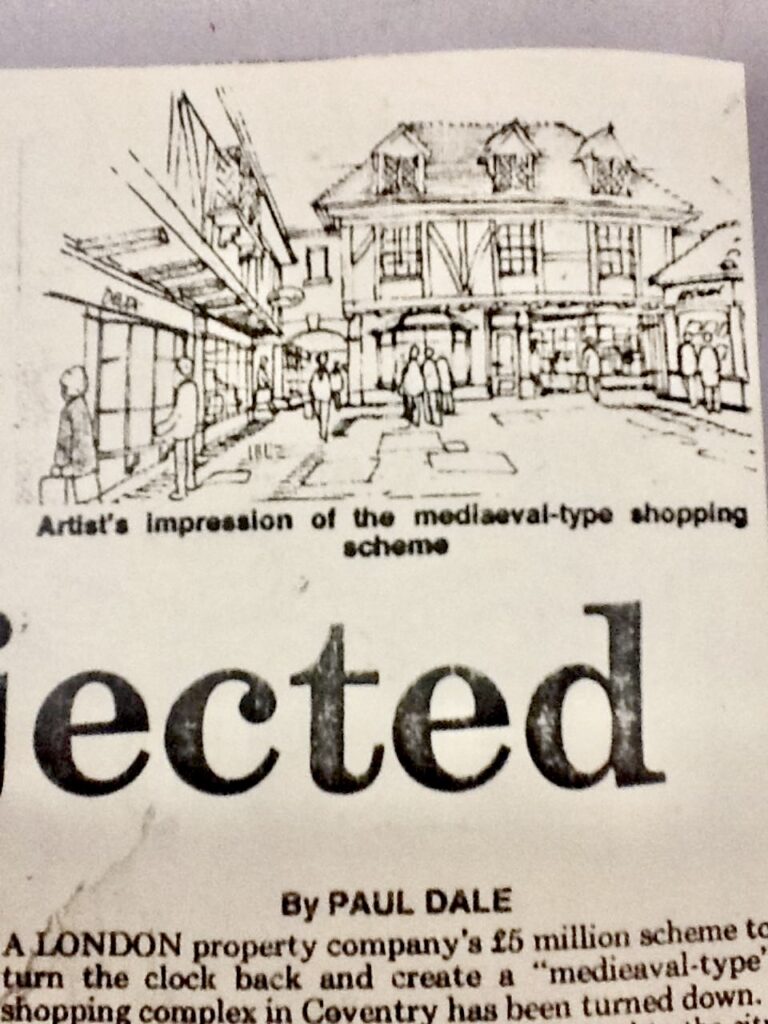
But the competition was won by another developer, St Martin’s Property Group, with the idea of Cathedral Lanes. The councillors voted on which scheme they liked, but there was some confusion and some councillors later admitted that they thought they were voting on the other scheme.
The plan was for two lanes, each an arcade, glassed over the top like many other Victorian arcades in different cities around the country. One lane would run towards the Cathedral spire area and go towards Broadgate and the Lady Godiva statue. The other lane would also start from the Cathedral but this would run towards the National Provincial Bank (please see attached plan).
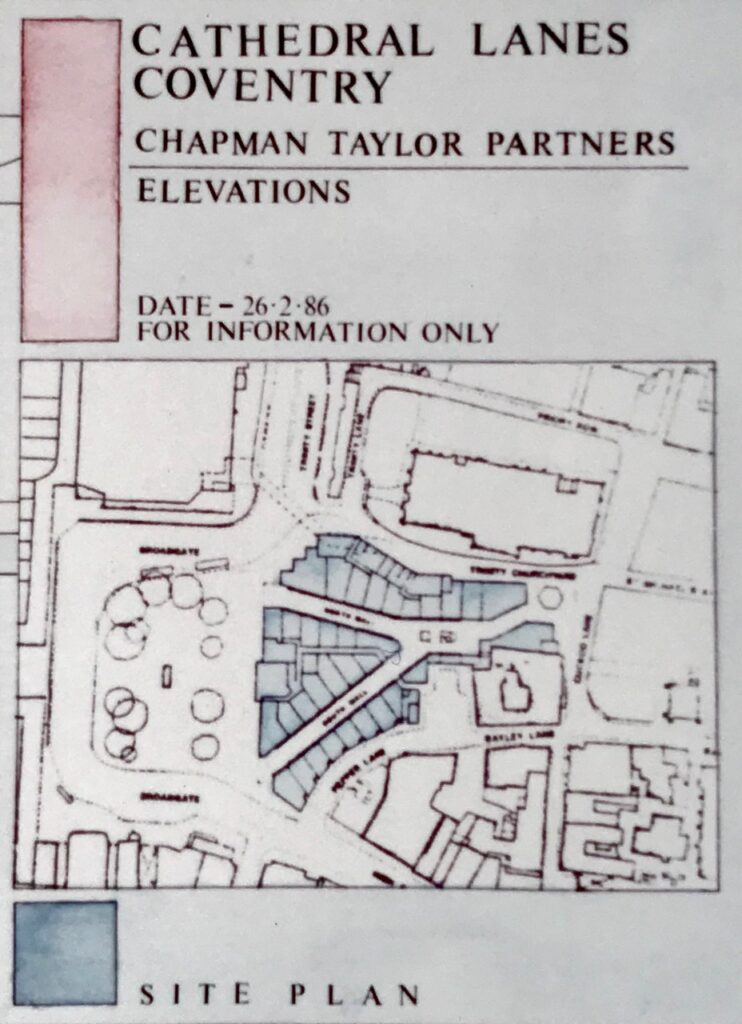
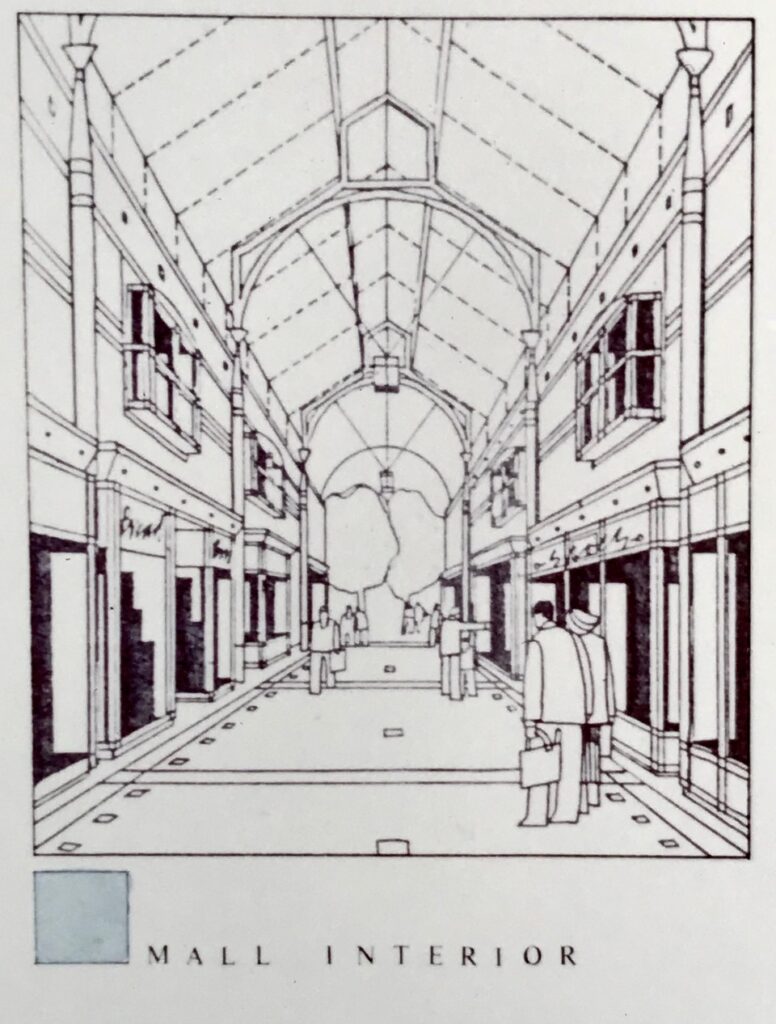
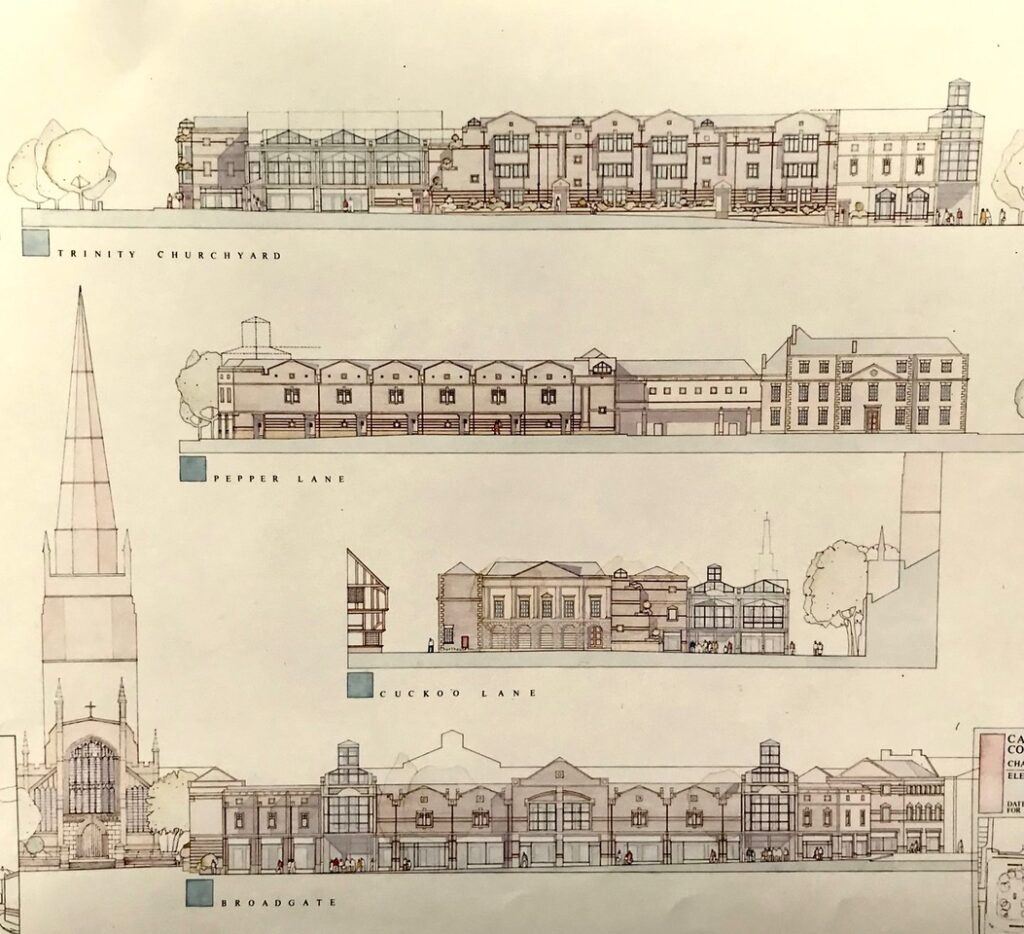
Plans were drawn up and a model was made and all the Coventry city councillors loved it. But it was 1986 and the country was in difficult times and to get money to develop a large scheme like this would require investment from outside the country. After a lot of investigation an investor was found but they felt that the idea of ground floor retail units with second floor access was not the best use of the development. So, they changed the interior lay out where visitor should be forced to go from one floor to the other floor if they wished to pass thought the complex and they took away the concept of the two lanes. The idea was when you go in through the front entrance you had to use an excavator or lift to get to the next floor then through to the back of the building and out the rear doors next to the county court facing the Cathedral spire.
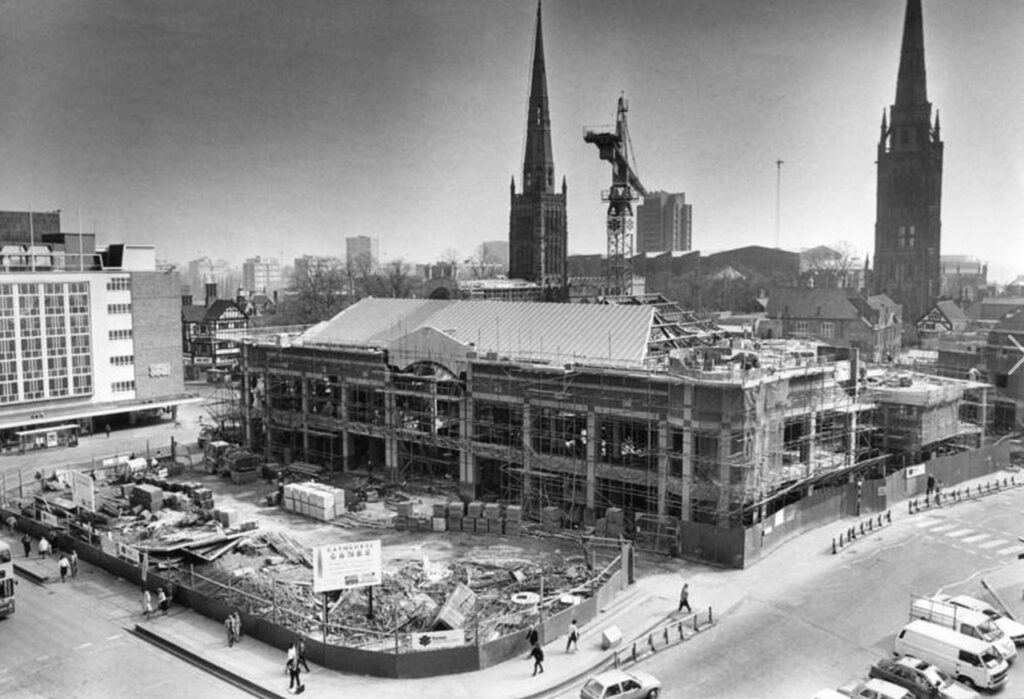
The very successful restaurant at the Belgrade Theatre was persuaded to move to Cathedral Lanes but were put at the very back of the development near the rear door. It was called a ‘Brasserie’. Unfortunately, a few things went wrong. Many people who were just passing through the building were walking through the restaurant, going in and out of the rear doors. Dinners were not happy being looked at why they ate and this area soon became very cold and uncomfortable, especially as the building opened on the night of 14th November 1990 in the middle of winter. The number of customers soon fell and the restaurant closed. The replacement retailer closed the doors permanently which took away the concept that it was ‘lanes’.
I have spoken to a lot of city ex-councillors who were in power when the ‘Cathedral Lanes’ was being developed. They said when it was finished it was nothing like the early designs they were shown. The concept of the two lanes had changed and they were not made aware of it. They still thought that as it was being called ‘Cathedral Lanes’ it would be two lanes.
It is said the main entrance to Cathedral Lanes is designed to look like the Broad Gate that would have been on the original castle and the towers on each corner represent castle towers (can you see them?). The building no longer has its tent out the front and it is now a bit like ‘Marmite’- you either love it or hate it. The development has how changed again to become mainly leisure and food outlets, which seems to be working well. I don’t think it will be going anywhere for a long time.
The moral of the story is, you have to keep your eye on developments as they can alter dramatically between concept, outline planning and the finished thing. The name may stay the same but it does not mean the product will end up being the same. We as a Society needs to keep our eyes on developments as they are happening and growing. We need to keep an eye on current developments such as City Centre South, Coventry University and the Ikea building, and many others in the pipeline.
